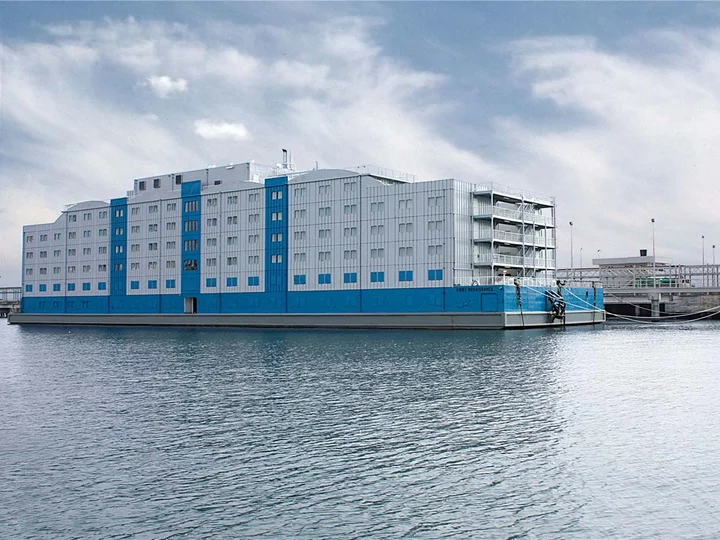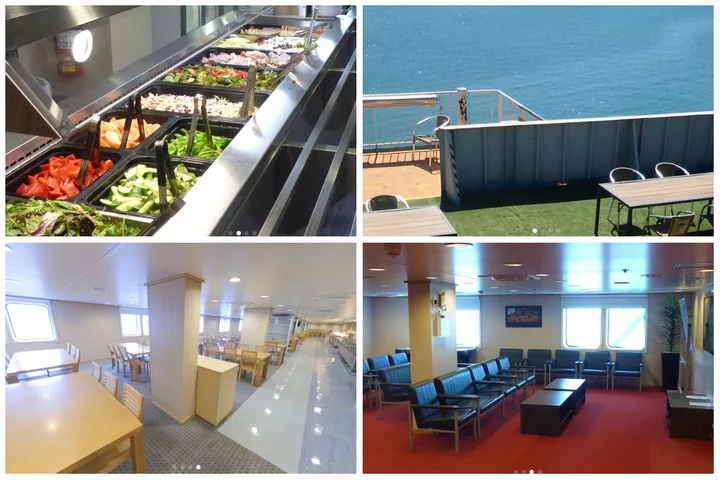The Bibby Renaissance is among several barges with dimensions, capacity and amenities that closely match specs provided by local officials. | Image via Bibby Maritime.
# # #
In desperate need of new student housing, Cal Poly Humboldt is looking to the water.
Local officials have been working with the university and state regulatory agencies to explore the potential of temporarily housing around 600 students aboard a multi-story residential barge docked in Humboldt Bay.
“The idea of floating apartments or studios is one of many possibilities the University has been exploring,” Cal Poly Humboldt Communications Specialist Grant Scott-Goforth said in an emailed response to questions from the Outpost. “This is very preliminary at this point and the university does not have further details to share.”
Eureka City Manager Miles Slattery tells the Outpost that the city has been discussing the barge proposal with regulators from the State Lands Commission, the Harbor District and other agencies.
“I think, personally, that this is a great idea,” Slattery said. “It would be a huge benefit to the City of Eureka, our businesses, to have this available.”
Stressing that the concept is still in the preliminary phase, Slattery said city staff have identified two potential dock locations that have the structural capability to host the vessel as well as the necessary water, sewage and electrical hookups.
He declined to identify a specific vessel or manufacturer but said the barge under consideration is 82 feet wide by 320 feet long and includes a cafeteria, a rooftop terrace, a workout room and other amenities.
“They’re nice,” he said. “If I was back at college and went to [Cal Poly Humboldt] I would be the first one to apply. I would live there before living in the dorms,” he added, noting that he lived at the Colony Inn during his own days on campus.
The barge would be a purely stop-gap solution while more permanent housing is constructed, Slattery said.
Amenities on the Bibby Renaissance include a cafeteria, rooftop terrace, dining hall and TV rooms. | Images via Bibby Maritime.
News of this proposal comes as the university finds itself in hot water with the current student body, many of whom rallied in the quad Wednesday to protest plans to house returning students at local hotels north of campus, including a Comfort Inn, Super 8 and Motel 6.
In his emailed statement, Scott-Goforth said, “As in many areas of California, there are simply not enough housing options available either on campus or in the community. The University has been looking into many creative solutions to provide additional high-quality and affordable housing for students. This includes the three hotels in Arcata, which serve to temporarily expand the available housing stock near campus.”
The Lumberjack student newspaper reported yesterday that there were “rumors and apparent email leaks” pertaining to the barge proposal. At least one student at yesterday’s protest objected to the idea, holding up a sign telling Cal Poly Humboldt President Tom Jackson, “Hey Tom! Don’t put us on a fucking prison boat!”
Barges like the ones being considered here have, in fact, been employed as floating prisons, though more often they’re used as temporary housing — or “floatels” — for employees on offshore or near-shore oil, mining and wind projects. During the worst of the COVID pandemic, one barge was used in Singapore to house healthy workers in a restricted area to avoid potential infection.
Slattery said that when the barge idea first came up, city staff reached out to RWE Offshore Wind Holdings, LLC, one of two energy corporations that won bids to develop offshore wind projects off the Humboldt County coast. The barge could work well to house their employees during construction, he said.
While Slattery is excited by the barge proposal, Humboldt Bay Harbor, Recreation and Conservation District Executive Director Larry Oetker has reservations. Reached by phone this morning he said his agency operates under the Public Trust Doctrine.
“In the Humboldt Bay Management Plan it says residential uses are generally not considered an acceptable public trust use of tidelands, with a few limited exceptions,” Oetker said. “I’m not saying we’ve made that determination, because we have not,” he added, noting that he has yet to see a detailed proposal, “but generally it is not acceptable in the long term to have these kinds of uses except in limited places,” such as live-aboard boats currently docked at Woodley Island Marina and the Eureka Small Boat Basin.
Melissa B. Kraemer, North Coast District manager for the California Coastal Commission, said in an email that there’s not much precedent for this type of thing along the California coast. Her agency would need to consider a number of issues before issuing a coastal development permit, including impacts on marine resources, water quality, parking/traffic/transit service, visual impacts, tsunami hazards and impacts to commercial fisheries and recreational boating.
Slattery said use of tidelands falls under the jurisdiction of the State Lands Commission, which is well aware of this proposal. The city has also consulted with the U.S. Coast Guard and the Army Corps of Engineers about any potential interference with Humboldt Bay’s navigation channels. The barge’s 82-foot width would “barely” extend into those channels, Slattery said.
While Slattery acknowledged that any work done below the mean high-tide line in Humboldt Bay is the purview of the Harbor District, he said that in his estimation there would be no “work” performed on the barge while it’s docked, meaning the Harbor District would be absolved of any responsibility.
City staff have discussed a number of other potential means of housing Cal Poly Humboldt students, including putting them up in the city’s own hotels or in the EaRTH Center housing and transit project being developed downtown. A previous administration at the university explored the idea of housing students on a cruise ship, Slattery said, though he noted that those vessels would be more difficult to accommodate because they have deeper drafts than residential barges.
Jennifer Kalt, executive director of environmental nonprofit Humboldt Baykeeper, said that while the barge idea took her aback when she first heard about it, she believes it could work.
“Humboldt Baykeeper has not seen any proposals, but the concept seems like it has a lot of potential and could be a good temporary solution with very little impacts to Humboldt Bay,” she said.
Below, enjoy a tour of the Bibby Renaissance and, if you’re so inclined, stick around for the mukbang.
Note: This post has been updated from its original version to add information from the California Coastal Commission.



CLICK TO MANAGE